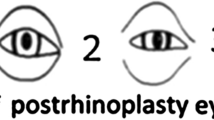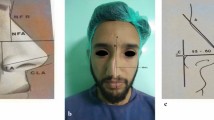Abstract
Background
The aim of study is to compare the external osteotomy vs. internal osteotomy in patients undergoing rhinoplasty.
Methods
The study group comprised of 45 patients that had undergone rhinoplasty surgery. The 25 patients had undergone internal / endonasal continuous lateral osteotomy and 20 patients had undergone external / percutaneous perforating digital osteotomy. The internal osteotomy was done high to low to high using 4 mm. curved guarded osteotome. The external osteotomy was done by 2 mm sharp osteotome. The scoring system of Kara and Gokalan was followed for edema and ecchymosis.
Conclusion
External osteotomy is an easy approach to carryout and makes fracture with high precision along preset lines. The bone stump is stable. The damage to the nasal mucosa is much less. There is reduced bleeding, reduced edema and reduced ecchymosis around eyes. The cutaneous scar at the entry site of osteotome is invisible.
Similar content being viewed by others
References
Lee HM, Kang HJ, Choi JH, Chae SW, Lee SH, Hwang SJ. Rationale for osteotome selection in rhinoplasty. The Journal of Laryngology & Otology 2002;116:1005–1008
Tardy Jr MA, Denneney JC. Micro-osteotomies in rhinoplasty. Facial Plast Surg. 1984;1:137–141(cross reference)
Rohrich RJ, Krueger JK, Adams WP, Jr., and Hollier LH Jr. Achieving consistency in the lateral nasal osteotomy during rhinoplasty: An external perforated technique. Plast. Reconstr. Surg.2001,108:2122, (cross reference)
Becker DG, McLaughlin RB Jr, Loevner LA, Mang A. The lateral osteotomy in rhinoplasty: Clinical and radiolographic rationale for osteotome selection. Plastic Reconstructive Surgery. 2000;105:1806–1816
Kara CO, Gokalan I. Effects of single dose steroid usage on edema, ecchymosis, and Intraoperative bleeding in rhinoplasty. Plastic Reconstructive Surgery. 1999;104:2213–2218
Denecke HJ, Meyer R. Plastic Surgery of the Head and Neck: Corrective and reconstructive Rhinoplasty. New York: Springer-Verlag; 1967 (cross reference)
Straatsma CR. Surgery of the bony nose:comparative evaluation of chisel and saw technique. Plastic reconstructive surgery. 1961;28:246 (cross reference)
Yucel OT. Which type of osteotomy for edema and ecchymosis external or internal. Annals of Plastic Surgery 2005;55(6)587–590
Rohrich RJ, Janis JE, Adams WP, Krueger JK. An update on the lateral nasal osteotomy in rhinoplasty; an anatomic endoscopic comparison of the external versus the internal approach. Plastic and Reconstructive Surgery 2003;2461–2462
Giacomarra V, Russolo M, Arnez ZM, Tirelli G: External osteotomy in Rhinoplasty, The laryngoscope. 2001;433–438
Kara CO, Kara IG, Tpuz B. Does creating a subperiosteal tunnel influence periorbital edema and ecchymosis in rhinoplasty? J oral Maxillofacial surgery 2005;1088–1090
Gryskiewicz JM, Gryskiewicz KM. Nasal osteotomies: a clinical comparison of the perforating methods versus the continuous technique. Plast Reconstructive Surgery. 2002;1445–1456
Author information
Authors and Affiliations
Corresponding author
Rights and permissions
About this article
Cite this article
Sinha, V., Gupta, D., More, Y. et al. External vs. internal osteotomy in rhinoplasty. Indian J Otolaryngol Head Neck Surg 59, 9–12 (2007). https://doi.org/10.1007/s12070-007-0002-9
Published:
Issue Date:
DOI: https://doi.org/10.1007/s12070-007-0002-9




